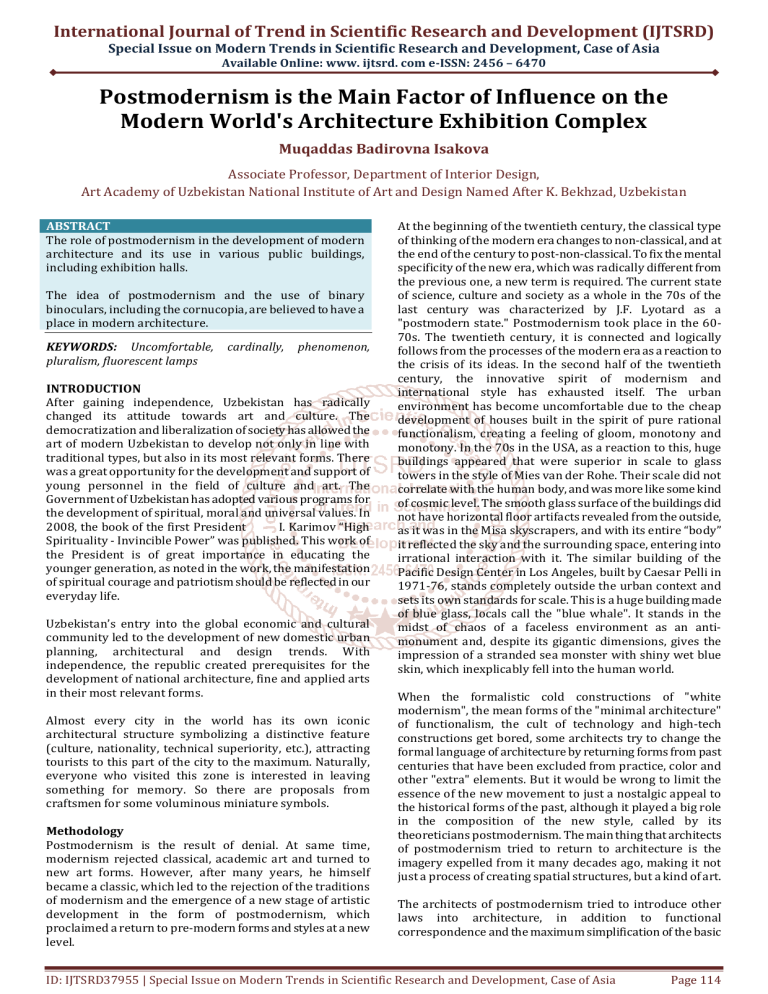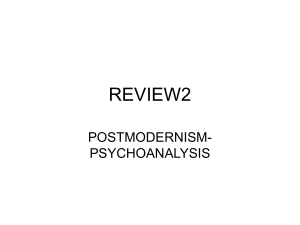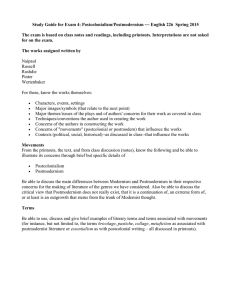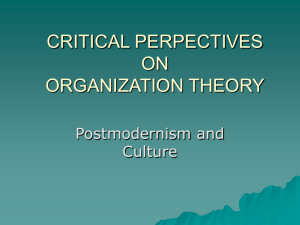
International Journal of Trend in Scientific Research and Development (IJTSRD)
Special Issue on Modern Trends in Scientific Research and Development, Case of Asia
Available Online: www. ijtsrd. com e-ISSN: 2456 – 6470
Postmodernism is the Main Factor of Influence on the
Modern World's Architecture Exhibition Complex
Muqaddas Badirovna Isakova
Associate Professor, Department of Interior Design,
Art Academy of Uzbekistan National Institute of Art and Design Named After K. Bekhzad, Uzbekistan
ABSTRACT
The role of postmodernism in the development of modern
architecture and its use in various public buildings,
including exhibition halls.
The idea of postmodernism and the use of binary
binoculars, including the cornucopia, are believed to have a
place in modern architecture.
KEYWORDS: Uncomfortable,
pluralism, fluorescent lamps
cardinally,
phenomenon,
INTRODUCTION
After gaining independence, Uzbekistan has radically
changed its attitude towards art and culture. The
democratization and liberalization of society has allowed the
art of modern Uzbekistan to develop not only in line with
traditional types, but also in its most relevant forms. There
was a great opportunity for the development and support of
young personnel in the field of culture and art. The
Government of Uzbekistan has adopted various programs for
the development of spiritual, moral and universal values. In
2008, the book of the first President
I. Karimov “High
Spirituality - Invincible Power” was published. This work of
the President is of great importance in educating the
younger generation, as noted in the work, the manifestation
of spiritual courage and patriotism should be reflected in our
everyday life.
Uzbekistan’s entry into the global economic and cultural
community led to the development of new domestic urban
planning, architectural and design trends. With
independence, the republic created prerequisites for the
development of national architecture, fine and applied arts
in their most relevant forms.
Almost every city in the world has its own iconic
architectural structure symbolizing a distinctive feature
(culture, nationality, technical superiority, etc.), attracting
tourists to this part of the city to the maximum. Naturally,
everyone who visited this zone is interested in leaving
something for memory. So there are proposals from
craftsmen for some voluminous miniature symbols.
Methodology
Postmodernism is the result of denial. At same time,
modernism rejected classical, academic art and turned to
new art forms. However, after many years, he himself
became a classic, which led to the rejection of the traditions
of modernism and the emergence of a new stage of artistic
development in the form of postmodernism, which
proclaimed a return to pre-modern forms and styles at a new
level.
At the beginning of the twentieth century, the classical type
of thinking of the modern era changes to non-classical, and at
the end of the century to post-non-classical. To fix the mental
specificity of the new era, which was radically different from
the previous one, a new term is required. The current state
of science, culture and society as a whole in the 70s of the
last century was characterized by J.F. Lyotard as a
"postmodern state." Postmodernism took place in the 6070s. The twentieth century, it is connected and logically
follows from the processes of the modern era as a reaction to
the crisis of its ideas. In the second half of the twentieth
century, the innovative spirit of modernism and
international style has exhausted itself. The urban
environment has become uncomfortable due to the cheap
development of houses built in the spirit of pure rational
functionalism, creating a feeling of gloom, monotony and
monotony. In the 70s in the USA, as a reaction to this, huge
buildings appeared that were superior in scale to glass
towers in the style of Mies van der Rohe. Their scale did not
correlate with the human body, and was more like some kind
of cosmic level. The smooth glass surface of the buildings did
not have horizontal floor artifacts revealed from the outside,
as it was in the Misa skyscrapers, and with its entire “body”
it reflected the sky and the surrounding space, entering into
irrational interaction with it. The similar building of the
Pacific Design Center in Los Angeles, built by Caesar Pelli in
1971-76, stands completely outside the urban context and
sets its own standards for scale. This is a huge building made
of blue glass, locals call the "blue whale". It stands in the
midst of chaos of a faceless environment as an antimonument and, despite its gigantic dimensions, gives the
impression of a stranded sea monster with shiny wet blue
skin, which inexplicably fell into the human world.
When the formalistic cold constructions of "white
modernism", the mean forms of the "minimal architecture"
of functionalism, the cult of technology and high-tech
constructions get bored, some architects try to change the
formal language of architecture by returning forms from past
centuries that have been excluded from practice, color and
other "extra" elements. But it would be wrong to limit the
essence of the new movement to just a nostalgic appeal to
the historical forms of the past, although it played a big role
in the composition of the new style, called by its
theoreticians postmodernism. The main thing that architects
of postmodernism tried to return to architecture is the
imagery expelled from it many decades ago, making it not
just a process of creating spatial structures, but a kind of art.
The architects of postmodernism tried to introduce other
laws into architecture, in addition to functional
correspondence and the maximum simplification of the basic
ID: IJTSRD37955 | Special Issue on Modern Trends in Scientific Research and Development, Case of Asia
Page 114
International Journal of Trend in Scientific Research and Development (IJTSRD) @ www. ijtsrd. com eISSN: 2456-6470
forms - fiction, imagination, theatrical game principle,
complex figurative associations. Another quality that
distinguishes the architecture of postmodernism, especially
in European countries, is a conscious desire to link new
buildings with the historical urban environment, without
spoiling it with new inclusions, to feel the urban context of
future buildings. Sometimes this trend of postmodernism is
called contextualism. An appeal to historical forms in
postmodernism is never directly quoted, instead a game of
hints of prototypes, encrypted symbolism and complex
associations appears.
In this sense, the sensational construction of Charles Moore Piazza Italy in New Orleans, a place chosen by the Italian
community of the city to host its festivals, can be seen as a
typical example. The desire of customers - to create the
material embodiment of nostalgia - the architect performed
in the form of a grotesque, creating a collage of classic
European architectural motifs, which is located around a
huge stone map of Italy. The very statement of the problem
here predetermined and justified the use of eclectic forms in
order to create an artistic image-association. Mario Botta
introduced some formal techniques into the architecture of
postmodernism, which were later used by his epigones and
became a kind of universal architectural language of
postmodernism. In his single-family houses - villas in
Switzerland, the ideas of solitude, isolation in a natural or
architectural environment are laid. His villas are selfsufficient, they do not need any communication. In a small
residential building, large forms are used, as if intended for
large public buildings - huge round windows with a mirrored
glass surface that protect the inner world even from outside.
The Austrian architect Hans Hollein in the interiors of the
Vienna Travel Bureau tried using architectural means to
convey the sensations, images, dreams and illusions that
arise from a person traveling to distant lands. Where a
modernist architect would have made glass walls and hung
them with advertising posters, Hollein sets up steel palm
trees, among which stands the ruin of a classical column.
Eagles fly over the ticket office. The space here is like a
scene, and the visitor, moving along it, is included in the
overall performance, starting to play some role. The
architect manages to create an atmosphere of something
unknown, mysterious, full of anticipation of the upcoming
trip and the discovery of some secrets. Often the architecture
of postmodernism is criticized for the fact that instead of
moving forward, it began to lead back into history,
explaining this by a fear of the future in the face of global
environmental disasters.
However, the main merit of postmodernism is that the
language of architectural forms has become incomparably
richer, volumes and compositions have become more
expressive, the concept of beauty and imagery has been
rehabilitated even in relation to strictly functional buildings.
The architects of postmodernism, showing respect for the
historical and national heritage, have created many
wonderful projects for the reconstruction of historical parts
of cities, assimilating modern buildings into the historical
fabric of the city without harming the parties. But the main
thing is that they returned architecture to the fold of art.
Postmodernism, the distinction of which is the rejection of
truth and universal pluralism, is a reaction to a change in the
place of culture in a post-industrial society. Such an attitude
towards culture arose due to a violation of the “purity” of the
phenomenon of art, the condition for which is semantic
generation, dating back to the creative principle, the original
creative act. These conditions were violated in the new
society with its endless possibilities of technical
reproduction, and the existence of art in its former forms
was called into question. Postmodernism, rejecting the
rationalism of the international style, turned to visual quotes
from the history of art, to the unique features of the
environment (which our epigones did not do, taking from
the postmodern only its primitively understandable
“omnivorousness”), combining this with the latest
achievements of building technologies. Architecture, as well
as fine art, proclaimed the principle of "open art", which
freely interacts with all old and new styles. In this situation,
the previous confrontation between tradition and the avantgarde loses its meaning. Having rejected the possibility of a
utopian transformation of life, postmodernists accept being
as it is and having made art extremely open, they filled it not
with imitations or deformations of life, but with fragments of
the life process. This process is usually only adjusted, and
not completely transformed into something new and
unprecedented. Postmodernism replaces the desire for
structural ordering with its understanding of growth
expressed in the concept of “rhizome”. Postmodernism itself
does not pretend to create a global theory; its world is a
world of “surfaces”, “games of particulars,” cultural variants
of previous eras. The worldview of postmodernism is a
fixation of a situation when repressive borders between
types, forms, and kinds of cultural activity disappear. The
concept of the center, which is the focus and symbol of
power, disappears as a result of the decentralization process,
which means the destruction of the central position of the
West as the traditional core of modern culture, as well as the
loss of the meaning of the theory of “two cultures”.
Previously, it was customary to think differently. In 1939,
American art critic Clement Greenberg wrote that kitsch and
avant-garde are two absolute poles of the culture of the 20th
century, and between them there is less and less something
third, that is, a traditional culture. If it does not become the
vanguard, it falls into kitsch, into a light chewing gum that
does not require the public anything but money. One of the
striking examples of kitsch, Greenberg considered Russian
Wanderers, in particular Repin, but believed that "Repin was
lucky that Russian peasants were protected from the
products of American capitalism: he would have no chance
next to the cover of the Saterdey Evening Post." The
correctness of Greenberg is easy to see today. But in the
same 1930s, the European philosopher Walter Benjamin
wrote another classic article, “A Work of Art in the Age of its
Technical Reproducibility”. And what Greenberg considered
kitsch's main drawback - his inability to intellectually
stimulate - Benjamin turned into a new aesthetic of
“distraction”, absorbing the viewer into himself, most typical
of cinema. As you can see, Benjamin looked at the future
sharper than Greenberg. Benjamin foresaw that mass
production would reach unprecedented technical and
aesthetic heights, and he turned out to be right: in the place
that kitsch occupied in the 19th century, today there were
mass media, TV, fashion, design and architecture of the postSoviet space of the “please” style. In the modern world,
dividing into a highbrow culture (what is commonly called
“classics” in our country) and lowbrow (mass, popular,
ID: IJTSRD37955 | Special Issue on Modern Trends in Scientific Research and Development, Case of Asia
Page 115
International Journal of Trend in Scientific Research and Development (IJTSRD) @ www. ijtsrd. com eISSN: 2456-6470
commercial) has completely lost its meaning: to be
commercial is a condition of survival. Instead of a world of
spiritual hierarchies, which is divided into high and low, we
live in a scattered world of a market that is divided into
mainstream and cult marginal. The mainstream has pop and
classic. A cult is considered just the vanguard and kitsch. A
striking example of postmodernism in museum architecture
is the Guggenheim Museum, opened in September 1997,
sensationally elevated modern architecture and the city itself
to the level of the 21st century. He contributed to the
renewal of the city and stimulated its further development. It
can be say that the structure here prevails over functions,
and that the architecture of the Guggenheim is perhaps
better known than what is inside; however, it is difficult to
resist the creation of Canadian architect Frank O Henry, with
inspiration using flowing canopies, cliffs, ledges, streamlined
shapes and turrets. Like all great architects, Henry designed
the Guggenheim, implying a certain historical and
geographical context. The place he chose was a production
wasteland, part of the district on the banks of the Ria de
Bilbao, where there were dilapidated and deteriorated city
warehouses. Bilbao's historic industries — shipbuilding and
fishing — reflected Henry’s own interests and, not least, his
previous experience with industrial materials. It is believed
that the brilliant titanium tiles that cover most of the
building and resemble the giant scales of herring are a
reflection of the admiration that the architect experienced in
childhood, watching the fish. The interior of the Guggenheim
is truly enormous, and this also has a special meaning. The
cathedral-like atrium is over 45 meters high. Light pours in
through the glass cliffs. From the atrium there is Gallery 104
- the “fish gallery”, a spacious arena 128 m long and 30 m
wide, where the structures of the “Snake of Richard Snake”
and its “Meaning of Time” are located, which are massive
sheets of iron, bizarre and incomprehensibly arranged,
between that you can wander around, dissolving in the
surrounding rusty red world among the muffled, whistling
and clanging metal sounds. Today, the tendency of the birth
of such museums is increasing every day.
Weisman Museum of Art, Minneapolis (USA). The building of
this museum is a complete abstraction, there is no single
system. This museum is very famous among architects,
designers, art historians, as well as ordinary people who like
unusual buildings. Denver Museum of Art, Denver (USA). The
building consists of large geometric elements, which
together constitute a single system, surprising in its
appearance. The influence of the designs of modern museum
complexes as a new period. Building materials and
structures by themselves do not have a large direct impact
on the architecture of museums and galleries.
In ancient times - in the Mycenaean era or in even earlier
epochs, when a person had almost no opportunity to process
building materials - their choice was offered by nature itself,
the only supplier of building material, thereby determining
all construction methods. The architecture of these primitive
eras can be called the “genius of finds”, because the inability
to process building materials made them look ready-made in
nature. Suitable blocks of stone, tree trunks, animal skins these are mainly the materials that could be used, and the
architecture itself consisted in their appropriate
combination. This primitive art gives us a special sense of
admiration for the first and modest victories of the human
mind over rough, untouched nature. Here we can
undoubtedly talk about the most concrete influence of
materials and construction methods on architecture.
The architecture of museums, therefore, in many ways
creates its own arsenal of materials and construction
methods. An in-depth analysis convinces us that the history
of museum architecture is not only a consistent change of
some completed structural solutions to others; rather, it is a
multilateral development process, which, due to the internal
interaction of all its factors, constantly generates new
solutions, new forms, new building materials, constantly
changes the very use of building structures. And instead of
just stating the influence of materials and structures on their
architecture, it will be more correct to not bias and carefully
consider this internal process, try to determine the nature of
the changes that occur in it. Consideration of the evolution of
the architectural forms of museums provides very
instructive material for modern architecture as a whole. In
the primitive era of the creation of the supporting frame, this
basic structural element, was perhaps the only problem in
architecture. Stone walls, their openings and floor beams that's almost all the architecture of those times. Somewhat
later, during the Hellenic culture, many details and their
combinations, in essence, were only small “processes” of the
supporting frame and often were completely inseparable
from it. Starting from Mycenae to the Parthenon, we see that
the beams made of natural stone for processing are similar
to stone blocks of walls and that most of the construction
tasks were solved along with the construction of the building
frame. Today, this only basic element of ancient architecture
- the frame - has changed so much that it has actually turned
into a light metal structure, the manufacture of which is just
a small part of the total volume of the structure. And if such a
metal structure in its character even resembles the tent
buildings of antiquity, it still differs from it in the most
significant way. The frame of a modern building, unlike its
ancient prototypes, is often not only not the largest part of
the entire structure in size, but, as a rule, is no longer crucial
for its architectural forms. The architecture of the building,
deprived of decorations, gives aesthetic satisfaction if it has
impeccable proportions; in addition, it will be interesting
and expressive subject to a certain compositional
completeness. The decor itself, when used correctly, can
have great expressiveness, and if it is not replaced by
something else that performs the same functions, the
architecture will lose more than win. When decorative
elements are used in excess, without the right attitude to the
main forms of construction, they are used obsessively, the
exposition building becomes clumsy and tasteless, beauty
turns into its opposite. When used correctly, decor gives
expressiveness to the architecture of the museum building,
introduces variety into it, dissecting smooth surfaces, serves
as an accent and punctuation tool, enhances the effects of
chiaroscuro and in some cases says something about the
purpose of this building. Another striking example of the
design innovation of museum complexes is the museum and
gallery of modern art in the city of Graz (Austria) called
Kunsthaus opened in 2003. The unusual shape of the
Kunsthaus Museum is fundamentally different from ordinary
exhibition halls. The team of architects used an innovative
stylistic language known as “drip architecture” (other
names: amoeba, blob, blobitektura, blobism). Due to the
unusual shape of the building, the creators affectionately
called it “Friendly Alien” (Friendly Alien). Surprisingly, the
rounded forms of the museum harmoniously fit into the
ID: IJTSRD37955 | Special Issue on Modern Trends in Scientific Research and Development, Case of Asia
Page 116
International Journal of Trend in Scientific Research and Development (IJTSRD) @ www. ijtsrd. com eISSN: 2456-6470
ensemble of traditional houses surrounding it, without
destroying the general structure of the landscape, but rather,
revitalizing it. The facade of the museum represents a special
fusion of architecture and new media, for which it received
the name BIX. BIX is an abbreviation formed by the words
"large" and "pixel", which most fully express the subtleties of
the technical side of the design. 900 square meters of the
“skin” of the giant amoeba are formed by plates of acrylic
glass, under which there are ring luminescent lamps with a
capacity of 93,040 watts. The voltage in each lamp can be
supplied in the range from 0 to 100%, which allows you to
demonstrate simple texts and graphics on the surface of the
building. The electrical installation is computer controlled.
Conclusion
Scientific knowledge is determined by the longevity
indicator of buildings. The emergence of new methods and
technologies of construction contributes to a new
development in the architecture of museum complexes and
the duration of their construction. Thus, we examined the
problem of modern culture as a factor influencing the object
of study, that is, postmodernism is the main factor
influencing the modern world architecture of exhibition
complexes, as well as museum architecture in the context of
modern culture. Today, other requirements and worldviews
are being posed. The new generation requires new ideas and
solutions.
List of literature:
[1] Gnedovsky M.B. M.B. Designing the past and the
museum of the future: metamorphoses of the project
approach in museum business // From design to
implementation / Sat. scientific / Research Institute
of Culture. -M., 1988.
[2]
Grechannikov S.N. Some principles of the spatial
organization of museum expositions // Art Museums
and Aesthetic Education of Workers / Sat. scientific tr.
/ research institutes of culture. -M., 1974.
[3]
Karataev JI. Museum exposition - science? //
Decorative art of the USSR, 1976, No. 9.
ID: IJTSRD37955 | Special Issue on Modern Trends in Scientific Research and Development, Case of Asia
Page 117




